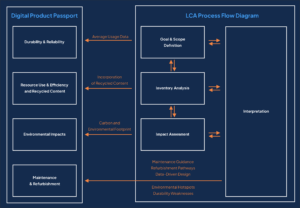The European Union’s adoption of Digital Product Passports (DPPs) under the Ecodesign for Sustainable Products Regulation is poised to set a new benchmark in environmental data collection, presenting a complex challenge of unprecedented scale for the EU. This initiative underscores the vital link with Life Cycle Assessments (LCAs), embedding comprehensive lifecycle information within DPPs and harnessing the analytical power of LCAs to hasten progress toward a circular economy. This integration has the potential to transform product design, empower informed consumer choices, and streamline regulatory compliance. However, realizing this potential hinges on addressing data management complexities and ensuring the technical compatibility of DPPs and LCA systems.
LCAs: Bridging the Data Gap in Digital Product Passports
LCAs are gaining prominence as indispensable tools for environmental sustainability in corporate strategy. Companies, facing pressures from environmentally conscious consumers and stringent regulations, are turning to LCAs to quantify and minimize the environmental impacts of their products. This surge in LCA adoption is evidenced by the market’s projected Compound Annual Growth Rate (CAGR) of 13.15% from 2022 to 2028, reflecting a value jump from US$314.59 million to over US$660 million.
Aligning LCA with EU Digital Product Passport Requirements
The meticulous data collection involved in the LCA process resonates with the key data points mandated by the EU for DPPs. As organizations grapple with Energy & Water Efficiency, LCAs offer insights into consumption patterns, which are vital for enhancing product sustainability throughout its lifecycle. This level of detail matches the EU’s vision for DPPs, which could include a comprehensive disclosure of energy and water use or the environmental product declaration altogether.
The LCA framework, established by ISO 14040 and 14044, begins with defining goals and scope —mirroring the DPP’s emphasis on Durability & Reliability by gathering average usage data (e.g., operating temperatures, cleaning requirements, frequency of use) as well as average usage duration (understanding whether the product is designed for short-term and frequent replacement, or longer, less frequent usage). This initial phase sets the stage for understanding the intended use and the target audience, ensuring that the LCA aligns with the product’s lifecycle requirements.
During the Life Cycle Inventory phase, the quantification of inputs and outputs aligns with the DPP’s “Resource Use & Efficiency and Recycled Content” categories. The data gathered here is crucial for optimising material usage and promoting the incorporation of recycled content in product design.
The Life Cycle Impact Assessment phase evaluates the environmental repercussions of these inputs and outputs. This stage correlates directly with the DPP’s Environmental Impacts category, aiming to quantify the product’s carbon and environmental footprint.
The LCA’s final phase, Interpretation, dovetails with the DPP’s focus on Maintenance & Refurbishment. The conclusions drawn here are critical for developing maintenance guidelines and refurbishment strategies, ensuring prolonged product life and sustainability.

LCA process & Digital Product Passport Synergies | Protokol
End-of-Life Considerations and Circular Economy
The end-of-life evaluation in LCAs, where the benefits of recycling and upcycling are assessed, is of particular relevance to the DPP’s Remanufacturing & Recycling category. This stage is pivotal for enabling effective remanufacturing and material recovery, which are central to the EU’s circular economy goals.
By weaving LCAs into the DPP fabric, companies can harness dynamic data management capabilities that meet and exceed the EU’s environmental transparency directives. Such integration paves the way for more accurate communication of a product’s environmental journey, fostering transparency, consumer enlightenment, and a collective stride towards more sustainable practices.
LCAs are not just a regulatory response but a strategic asset, enabling businesses to stay ahead of sustainability curves and embedding environmental responsibility into the core of product life cycles. The growing LCA market is a testament to its critical role in shaping an eco-conscious future, bolstered by policies like the EU’s ESPR and the advent of DPPs.
The Data Disparity Challenge in LCAs and how DPP’s might help
Life Cycle Assessments are meant to illuminate the environmental impact of products throughout their journey. Unfortunately, the reliability of LCA outcomes is often plagued by incomplete or outdated data, along with a lack of consistent, granular reporting across interconnected supply chains. Industry studies indicate this ‘data disparity’ issue impacts upwards of 70% of LCAs, compromising their value as informed decision-making tools for sustainability practitioners.
A study from 2022 reveals that dynamic data management can significantly impact LCA accuracy. It found that monthly LCA results could fluctuate by ±14% due to the variability of foreground inventory data throughout the year. Furthermore, the choice of background datasets, Life Cycle Impact Assessment (LCIA) methods, and adherence to different environmental label rules could lead to variations in LCA outcomes by as much as 20%. Crucially, LCAs often rely on averaged metrics for processes from databases, especially when specific proprietary data is not available. This reliance on average metrics can skew the data, affecting the accuracy and reliability of LCAs. Such averaged information, while necessary without specific data, underscores the challenges in achieving precise environmental impact assessments through LCAs.
This underscores the critical role of sophisticated data management tools in capturing the complexities of industrial processes and improving the precision of environmental impact assessments. The integration of DPPs with LCAs stands out as a significant advancement in this direction. DPPs, by offering access to primary, granular data across a product’s lifecycle — from material extraction through manufacturing, use, and end-of-life stages — directly address the current challenges in LCA methodologies. This reliance on primary rather than generic or secondary data mitigates the common issue of significant over- or underestimations of environmental impacts, enhancing the accuracy of environmental assessments.
Furthermore, the capacity of DPPs to provide real-time updates on product information introduces an unprecedented level of dynamism into LCA practices. This allows assessments to rapidly adapt to changes in material sourcing, manufacturing processes, or end-of-life strategies, offering a more accurate and timely depiction of a product’s environmental footprint.
Technical Challenges in Integrating DPPs and LCAs
However, the journey towards integrating DPPs with LCAs is fraught with technical challenges. One of the foremost issues is the lack of standardization in data formats and interoperability protocols. This disparity poses a significant barrier to the seamless integration of DPP information with LCA software, potentially leading to discrepancies in environmental impact assessments. The technical intricacies of aligning disparate data systems necessitate a concerted effort to develop unified data standards and interoperability frameworks that can support the fluid exchange of information between DPP platforms and LCA tools.
Moreover, a study on sustainability highlights the nuanced complexities of industrial processes and the critical need for sophisticated data management tools to improve LCA precision. It points out that achieving accurate environmental impact assessments requires not just access to real-time and granular data but also the ability to navigate and harmonize diverse data sources and methodologies within the LCA framework.
Addressing these technical challenges is pivotal for leveraging the full potential of DPPs in enhancing LCA accuracy and reliability. It calls for an integrated approach involving stakeholders across the spectrum—manufacturers, regulatory bodies, technology developers, and sustainability practitioners—to forge standardized, interoperable solutions that bridge the data divide. Such advancements would not only refine environmental impact assessments but also empower businesses and regulators with the insights needed to drive sustainable product development and policymaking.
Benefits of Early Digital Product Passport Adoption for Your LCA Function:
- Enhanced Data Accuracy: Leveraging the granular and primary data from DPPs will significantly reduce the reliance on generic databases, improving the accuracy of your LCAs.
- Dynamic Sustainability Insights: With real-time updates provided by DPPs, your environmental assessments will reflect the most current product information, allowing for agile adjustments to sustainability strategies.
- Streamlined Compliance and Reporting: Early adoption of DPPs streamlines the process of meeting future regulatory requirements and simplifies sustainability reporting, making it more transparent and credible.
- Strategic Sustainability Leadership: By integrating Digital Product Passports data with LCAs in some capacity, your organisation not only meets regulatory expectations but also demonstrates leadership in sustainability, enhancing brand reputation and stakeholder trust.
Advantages of Incorporating LCA Insights into DPP Strategy:
- Optimisation for Sustainability Compliance: Early integration of LCA data into the DPP framework can streamline adherence to environmental regulations, ensuring products meet sustainability criteria before market introduction.
- Transparency in Environmental Impact: Embedding comprehensive LCA findings within DPPs enhances the transparency of a product’s environmental footprint, fostering greater consumer trust and informed decision-making.
- Market Leadership in Sustainability: Leveraging LCA analyses to inform Digital Product Passport content positions companies as pioneers in sustainability, enhancing brand differentiation and leadership in eco-friendly innovation.
Conclusion
Integrating Life Cycle Assessment data into Digital Product Passports (and vice versa) creates a potent tool for sustainability, enhancing transparency and decision-making across product lifecycles. This synergy propels products towards a circular economy, emphasising ecological considerations from design to disposal. This approach not only aligns with EU sustainability goals but sets a new standard for global product management. To learn more about Digital Product Passports read our complete guide to Digital Product Passports or, if you’re seeking to understand how you can utilise DPPs within your LCA strategy, reach out to Protokol here.




